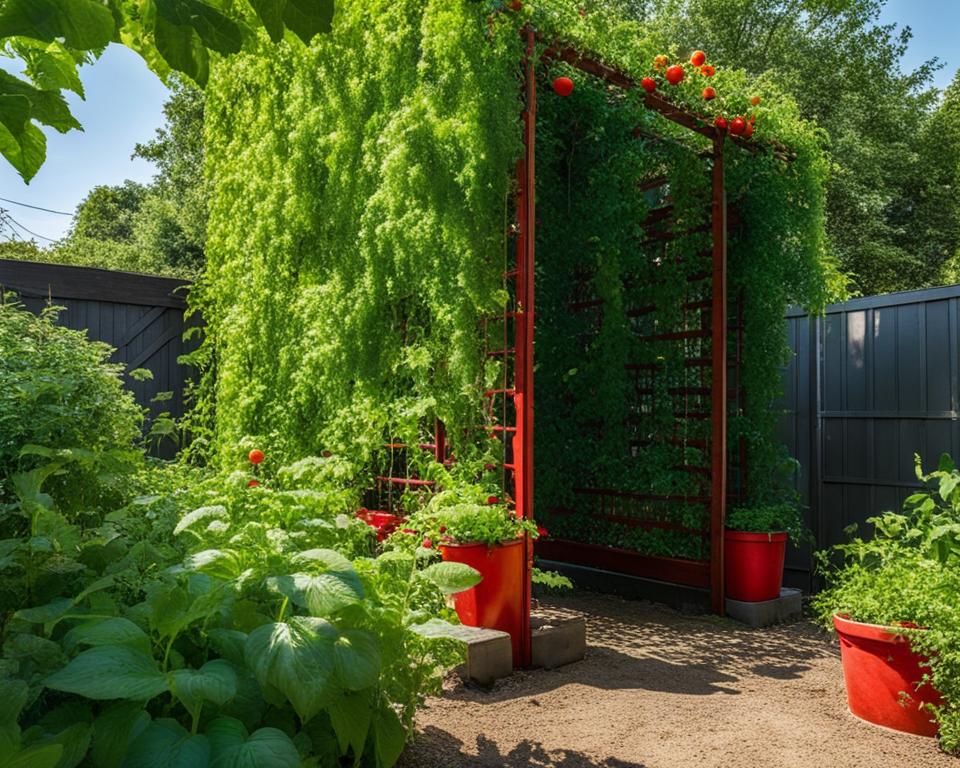If you’re looking to make the most of your available gardening space, vertical vegetable gardening is an excellent solution to maximize your harvest. Perfect for urban settings or areas with limited room, vertical gardening is a creative and efficient way to grow more food. With our vertical gardening tips, you’ll learn how to master this space-saving and visually appealing approach to gardening!
Key Takeaways
- Vertical vegetable gardening optimizes space and increases yield per square foot.
- This method is ideal for urban environments or areas with limited space.
- Utilize structures like trellises, towers, and wall planters to support your vertical crops.
- Choose vegetables with growth patterns suitable for vertical gardening, such as vines or climbing varieties.
- Proper sunlight, airflow, and container selection are essential for a successful vertical garden.
- Vertical gardens in urban settings contribute to city sustainability and personal well-being.
- Experiment with DIY projects and creative designs to make your vertical vegetable garden unique.
The Basics of Vertical Vegetable Gardening
Vertical vegetable gardening is an innovative and practical approach to small space gardening, allowing for optimal use of limited areas while enhancing the visual appeal of your garden. To establish a successful vertical garden, you must understand the basics, such as selecting proper structures, choosing the right soil and containers, and managing sunlight and watering. This knowledge will prepare you for more advanced vertical gardening techniques.
Vertical garden systems typically involve various types of structures to support the plants’ growth, including:
- Trellises
- Towers
- Wall planters
Each structure has its advantages and works best with certain plant types. For instance, trellises are ideal for vining plants like beans and peas, while towers may be better suited for compact plants like strawberries. Wall planters are perfect for shallow-rooted plants such as herbs and lettuce.
“The right vertical garden structure can make a world of difference in supporting your plants’ growth and maximizing your harvest in small gardening spaces.”
When it comes to soil and containers, it’s essential to choose the right potting mix and container to support your plants’ needs. The soil should provide excellent drainage and nutrients, while the container must offer sufficient depth for root growth and adequate drainage holes. Remember that certain plants may require larger containers or more soil, so be prepared to adjust accordingly.
Sunlight and watering play a crucial role in the growth and health of your vertical garden. Keep in mind that most vegetables require at least six hours of sunlight daily, so position your garden in a sunny location. Additionally, consider implementing an efficient irrigation system or regularly watering your plants to prevent dehydration, as vertical gardens tend to dry out faster than traditional ones.
- Choose a suitable vertical garden structure according to your plants’ growth habits and size.
- Ensure your soil and containers provide excellent drainage, nutrients, and space for root growth.
- Place your vertical garden in a sunny location, and maintain consistent watering to prevent dehydration.
By mastering these basics of vertical gardening, you’ll create a solid foundation for a thriving vertical vegetable garden, maximizing your small space while fostering the growth of healthy and bountiful plants.
Choosing the Right Location for Your Vertical Garden
When setting up your vertical garden, it’s crucial to choose the appropriate location considering factors such as sunlight and shade, as well as space and airflow. These factors significantly influence the health and productivity of your garden.
Considering Sunlight and Shade
Different vegetables have varying sunlight requirements for optimal growth. Some thrive in full sun, while others prefer partial shade. When selecting the right location for your garden, you need to analyze the amount of sunlight each area receives and choose the appropriate vegetables accordingly.
| Full Sun Vegetables | Shade-Tolerant Vegetables |
|---|---|
| Tomatoes | Lettuce |
| Peppers | Spinach |
| Cucumbers | Kale |
| Eggplant | Swiss Chard |
Monitoring the sun patterns in your potential garden space throughout the day will help you determine the most suitable location for each vegetable, ensuring a healthy and bountiful harvest.
Assessing Space and Airflow
When choosing the right location for your vertical garden, you need to consider space efficiency and proper airflow. Vertical gardens in small spaces can lead to overcrowding, which impedes air circulation, increasing the likelihood of diseases and pests. By arranging vertical elements like trellises and container placements strategically, you can avoid overcrowding without sacrificing productivity.
- Maintain Appropriate Spacing: Ensure adequate distance between vertical structures and plants, so each plant has enough room to grow and air can circulate freely.
- Utilize Wall Space: Maximize the use of wall space by installing wall-mounted planters or hanging baskets, which not only improve airflow but also create visual interest.
- Stagger Container Placements: Place containers at varying heights to make efficient use of available space and prevent plants from competing for sunlight and air.
By committing to proper garden space planning, you will create an environment conducive to optimal growth and plant health, allowing your vertical garden to flourish.
Selecting Vegetables for Your Vertical Garden
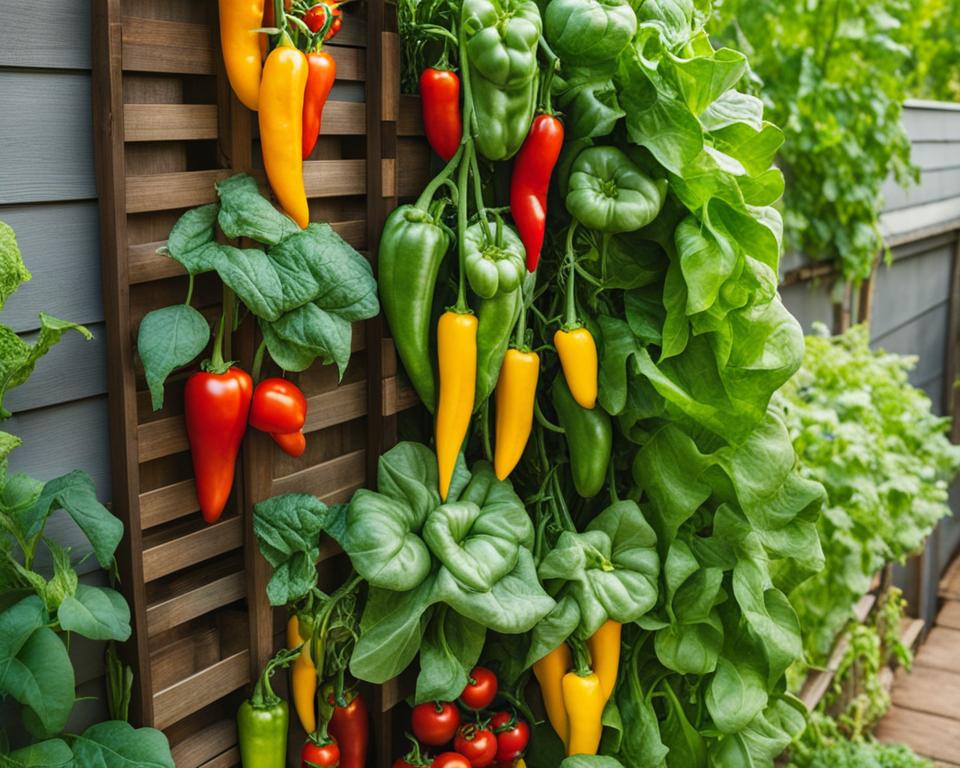
Choosing the right vertical garden vegetables is crucial for enjoying a bountiful harvest. Factors to consider are the weight of mature plants, their growth patterns, and the diverse support structures that different vegetables may require. Here, we offer guidance on selecting the best vegetables for vertical gardening.
“Grow up!” That’s the advice we give to our plants in a vertical garden. Let’s make the most of the available vertical space by selecting the right vegetables to plant.
- Weigh your options: Consider the weight of mature plants, as heavier plants may require stronger support structures.
- Growth patterns: Some plants like leafy greens or vining plants are better suited for growing upward, while others might prefer to spread out horizontally.
- Support system: Understand the support each vegetable type requires, such as stakes, trellises, or cages.
| Vegetable | Growth Pattern | Support Required |
|---|---|---|
| Tomatoes | Vining | Cage, stakes, or trellis |
| Pole Beans | Climbing | Trellis or poles |
| Peas | Climbing | Trellis or netting |
| Cucumbers | Vining | Trellis or A-frame |
| Zucchini | Bushy, Vining | None or trellis |
| Swiss Chard | Leafy | None |
| Lettuce | Leafy | None |
| Kale | Leafy | None |
By considering these factors and selecting the best vegetables for vertical gardening, you can maximize your harvest and make the most of your vertical garden. Don’t be afraid to experiment and find the perfect combination of vegetables to cultivate in your unique space!
Benefits of Vertical Gardening in Urban Areas
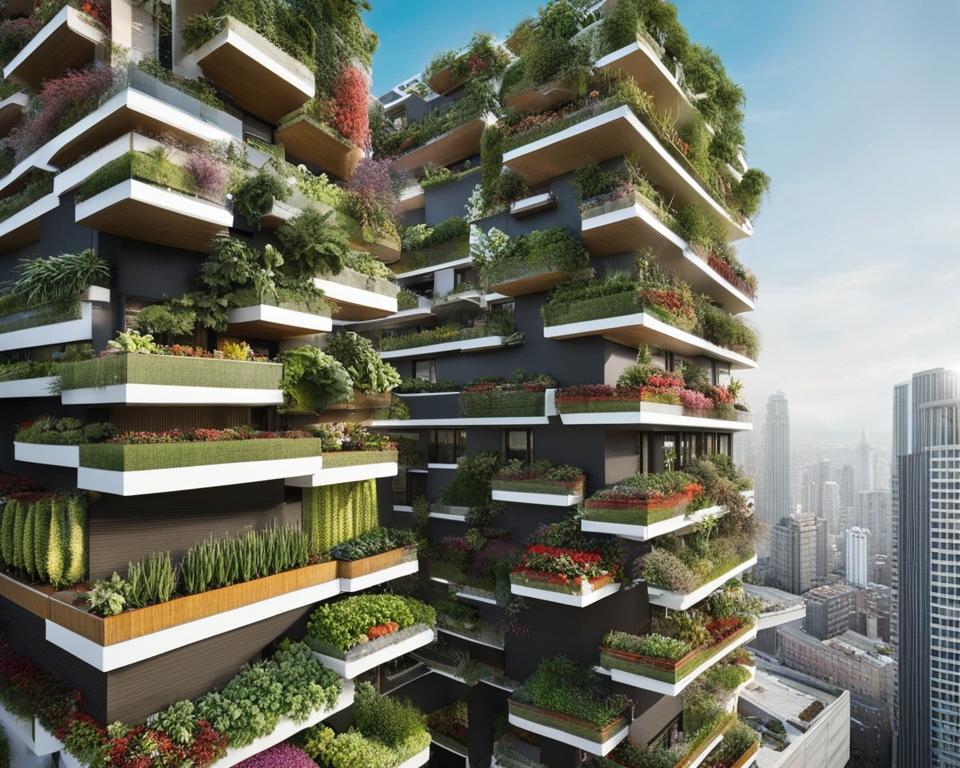
Urban gardening is becoming increasingly popular as city dwellers seek ways to reconnect with nature and grow their own food. Vertical gardening presents numerous advantages for those living in urban settings, providing a sustainable solution to maximize the use of limited space. Vertical gardening in small spaces, such as balconies, rooftops, and patios, transforms previously underutilized areas into thriving green spaces that contribute positively to city life and personal well-being.
Making the Most of Limited Space
The primary advantage of vertical gardening in small spaces is the efficient use of space. Urban gardeners must often contend with cramped living conditions that seemingly offer little room for traditional, ground-level gardening. However, by growing plants vertically, gardeners can make the most of their limited space and still enjoy the benefits of cultivating fresh produce and beautiful flowers. The following table highlights several popular vertical gardening techniques, their main advantages, and suitable plants to grow in such systems.
| Vertical Gardening Technique | Main Advantages | Suitable Plants |
|---|---|---|
| Trellises | Effective use of vertical space, improved air circulation, and support for vining plants | Climbing vegetables (e.g., tomatoes, cucumbers, peas), flowering vines |
| Wall Planters | Transforms bare walls into green spaces, enables gardening on balconies and small patios | Herbs, small vegetables (e.g., lettuce, kale, strawberries), succulents, ornamental plants |
| Tower Planters | Efficient use of space for high-yielding crops, suitable for rooftop gardening | Leafy greens, small root vegetables (e.g., radishes, carrots), herbs |
In addition to the efficient use of space, vertical gardens contribute to city sustainability by helping to reduce the urban heat island effect through increased greenery. The addition of greenery and plant life in urban areas results in cooler air temperatures and improved air quality for city dwellers. Not only do vertical gardens in small spaces contribute to the overall well-being of the city, but they also provide numerous personal benefits. By engaging in urban gardening, individuals can experience the therapeutic effects of tending to plants, which has been shown to reduce stress and promote mental well-being.
“Gardens and flowers have a way of bringing people together, drawing them from their homes.” – Clare Ansberry
In summary, vertical gardening is a highly advantageous solution for urbanites with limited space. By employing inventive gardening techniques, city dwellers can transform their balconies, rooftops, and patios into verdant, flourishing oases, contributing to city sustainability and improving their overall well-being.
Design Ideas for Vertical Vegetable Gardens
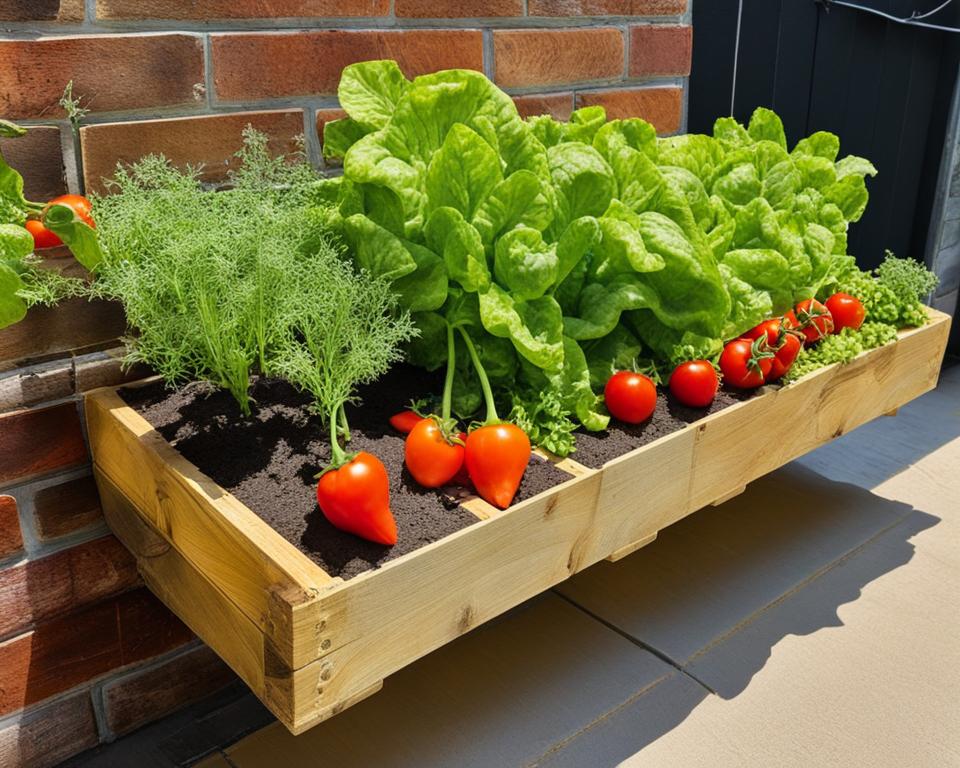
Creating a visually appealing and efficient vertical garden design is key to maximizing your harvest and making the most of your available space. In this section, we will explore various design ideas for vertical vegetable gardens, ranging from ready-made vertical planters to more creative approaches.
Utilizing Vertical Planters
Vertical planters offer a practical and aesthetically pleasing solution for growing vegetables vertically. There are numerous options available on the market, from tiered planters to wall-mounted pocket planters, that cater to different garden sizes and style preferences. Vertical planters help maximize your garden’s potential and can be easily integrated into your existing outdoor or indoor space. Some of the most popular vertical planter options include:
- Stacked planters: Designed for multiple levels, these planters offer space for several vegetables, herbs, or flowering plants to grow vertically within a compact area.
- Wall-mounted pocket planters: Made from a variety of materials, such as fabric or plastic, these planters contain individual pockets for planting and hanging on walls or fences.
- Trellis planters: A planter box with a built-in trellis, perfect for supporting vining vegetables or climbing plants.
DIY Vertical Garden Structures
For those who prefer a more personalized touch, there are countless DIY vertical garden projects that allow you to create your own unique garden structures. DIY vertical gardens offer the satisfaction of customization, as well as the opportunity to repurpose or upcycle materials that may be readily available. Some creative vertical gardening ideas for DIY projects include:
- Pallet gardens: Repurpose wooden pallets by attaching landscape fabric to the back, filling them with soil, and planting your vegetables in the slats.
- Ladder gardens: Utilize an old ladder as a structure for hanging a collection of small pots or attaching planter boxes.
- Utility shelving gardens: Convert utility shelves into a vertical garden by adding containers, planting trays, or even gutter planters to the shelves for compact and efficient growing space.
By exploring different vertical garden design ideas and incorporating a mix of store-bought and DIY solutions, you can create a one-of-a-kind vertical vegetable garden that is both visually appealing and productive.
Implementing a Vertical Herb Garden
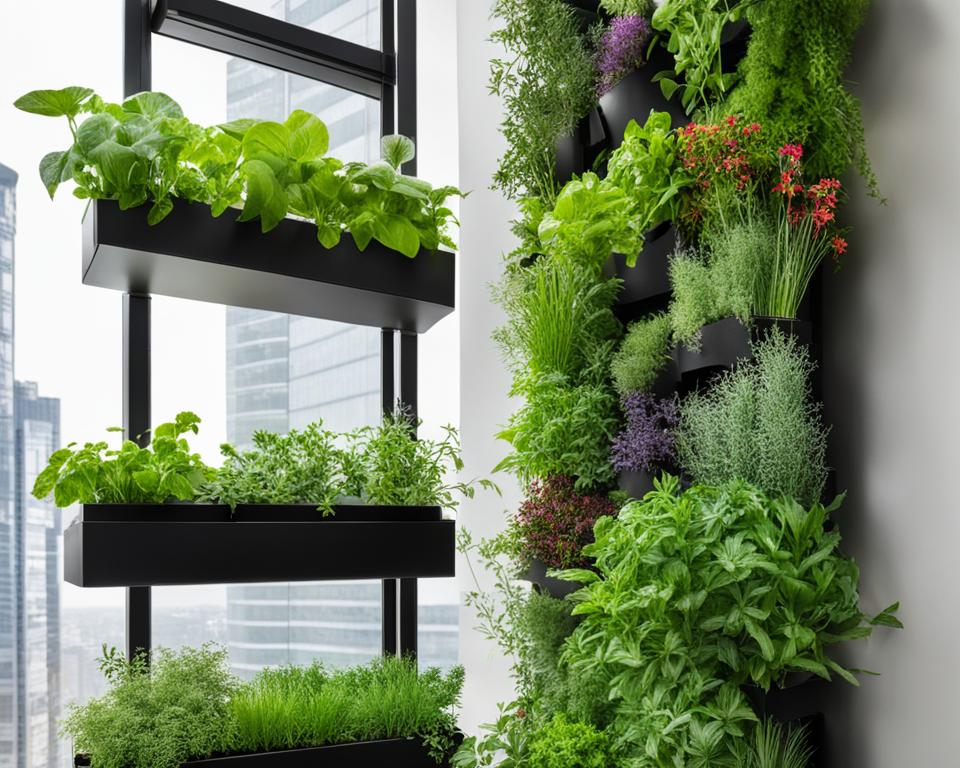
A vertical herb garden is a great addition to any space, providing fresh, aromatic herbs for your cooking while saving space and adding aesthetic appeal. In this section, we’ll go over the best herbs for vertical gardening, tips for harvesting and maintaining their growth, and the benefits of companion planting.
When starting your herbal gardening journey, it’s essential to select herbs that grow well vertically. Some popular, easy-to-grow options that thrive in this setting include:
- Thyme
- Rosemary
- Basil
- Oregano
- Parsley
- Mint
- Chives
- Marjoram
Each herb has its own unique growth habits and requirements, so it’s crucial to research each plant to ensure they receive the proper care. Most herbs require plenty of sunlight, well-draining soil, and regular watering for optimal growth.
“Fresh herbs can transform ordinary meals into something special by adding flavor, aroma, and visual appeal.”
To maximize your herbal gardening yields, harvest your herbs consistently to promote continual growth. Pinching off the top portion of each stem will help maintain the plant’s size, encourage bushier growth, and prolong its life in your vertical garden. Remember to always leave enough foliage to support the plant’s continued growth.
Companion planting is another effective vertical gardening idea to ensure your garden’s success. Pairing herbs with compatible plants can improve flavor, deter pests, and even boost each plant’s health and growth.
| Herb | Companion Plant |
|---|---|
| Basil | Tomatoes, Peppers |
| Rosemary | Beans, Brassicas |
| Parsley | Tomatoes, Corn |
| Chives | Carrots, Lettuce |
An attractive component of a vertical herb garden is the ability to mix and match various herbs, creating a visually pleasing and functional garden. Along with the practical benefits of fresh herbs, vertical herb gardens can elevate the aesthetics of your outdoor or indoor space. Take into consideration the colors, textures, and height differences of your chosen herbs, and experiment with different arrangements to find the one that suits your taste and needs.
Overall, a vertical herb garden offers numerous benefits – from saving space and enhancing garden aesthetics to providing fresh herbs at your fingertips. With some planning and care, you can cultivate a thriving herb garden that will reward you with an abundance of flavor and fragrance.
Container Gardening: A Versatile Option for Vertical Growers
Container gardening plays a significant role in the vertical gardening concept, providing versatility and adaptability for your garden. Using containers for vertical gardening allows you to rearrange your plants and create varying levels to make the most of your available space. In this section, we will discuss suitable container types and how they can complement different plant requirements.
Both traditional and more innovative pots for vertical gardening can be used to elevate your garden’s aesthetic appeal and promote plant growth. Choosing the right container type is crucial in ensuring your plants receive proper support, maintain optimal moisture levels, and remain healthy throughout their growth cycle.
- Plastic Pots: Lightweight and affordable, plastic pots are a popular choice for container gardening. They come in various sizes and styles, offering versatility for your plant arrangements.
- Terracotta Pots: Terracotta pots are made from breathable clay, which helps regulate moisture levels. They are heavier than plastic pots, providing better stability for your vertical gardening structures.
- Fabric Pots: Fabric pots, also known as grow bags, offer excellent aeration and moisture control. They are lightweight and portable, making them a suitable option for those who want to rearrange their garden frequently.
- Hanging Baskets: Hanging baskets bring a touch of elegance to your vertical garden. These containers can be made from various materials like wire, plastic, or coco fiber and are ideal for plants that naturally cascade or creep.
When selecting containers for your vertical garden, keep in mind the specific needs of your plants, such as root depth, water requirements, and sunlight exposure. This will help you in determining the size and material of your chosen container. Additionally, consider using brackets, shelves, or support systems designed to secure your containers in a vertical arrangement.
“Container gardening combines the beauty of nature with the practicality of modern-day living. It is a versatile gardening method that can be adapted to suit any space or growing condition.”
| Container Type | Advantages | Drawbacks |
|---|---|---|
| Plastic Pots | Affordable, lightweight, variety of sizes and styles | Less durable, poor insulation in harsh climates |
| Terracotta Pots | Natural material, breathable, good stability | Heavier, can crack in extreme temperatures |
| Fabric Pots | Excellent aeration, moisture control, lightweight | Less rigid, may need additional support |
| Hanging Baskets | Visually appealing, ideal for cascading or creeping plants, saves floor space | Limited soil capacity, may require more frequent watering |
In conclusion, container gardening is a versatile approach that can easily be incorporated into a vertical gardening setup. By selecting suitable containers and considering the specific needs of your plants, you can create a fruitful and visually appealing vertical garden that fits your available space and personal style.
Irrigation Solutions for Vertical Vegetable Gardening
Proper watering is a crucial aspect of maintaining a healthy and productive vertical garden. Implementing efficient irrigation for vertical gardens ensures that your plants receive the right amount of moisture without waste or overwatering. In this section, we’ll discuss several efficient watering systems that can help you optimize your vertical garden watering routine.
Efficient Watering Systems
Utilizing the appropriate watering system for your vertical garden can help you conserve water, reduce labor, and promote healthy plant growth. Let’s explore some of the most effective watering systems for vertical vegetable gardens:
- Gravity-Based Systems: This type of system is designed to utilize gravity to distribute water throughout the vertical garden. A reservoir is placed above the garden, and water travels downward through tubes or channels to reach the plants. Gravity-based irrigation systems are cost-effective and easy to set up, making them a popular choice for beginners.
- Drip Irrigation: Drip irrigation is an efficient method of delivering water directly to your plants’ root zones. This targeted watering technique reduces water waste and prevents potential issues associated with overwatering. Drip irrigation systems typically consist of a network of tubes and emitters that can be customized to distribute water to specific plants as needed.
- Self-Watering Planters: Self-watering planters are designed to provide consistent moisture to your plants with minimal input from you, the gardener. These planters have built-in reservoirs that hold water and release it to the plant’s roots through a wicking mechanism. Self-watering planters are convenient for busy gardeners and can help to conserve water.
- Recirculating Watering Systems: These systems use a combination of pumps and tubing to circulate water throughout your vertical garden continuously. Recirculating systems can help to evenly distribute moisture and nutrients to your plants while reducing water waste.
Keep in mind that the best watering system for your vertical vegetable garden may depend on factors such as your plants’ specific needs, your available resources, and your overall gardening goals.
Choosing an efficient watering system for your vertical garden can greatly influence the success and sustainability of your garden. By understanding the advantages of different irrigation solutions, you can select the best method for your unique situation and cultivate a thriving vertical vegetable garden.
Maintenance Tips for a Healthy Vertical Garden
Proper maintenance is essential for the success of your vertical garden. This section will provide you with tips on pruning, plant care, and pest control to ensure that your garden remains productive and thriving.
Pruning and Plant Care
Pruning is an essential aspect of plant care in vertical gardening. Timely pruning helps to maintain the desired shape and size of the plants, improves air circulation, and ultimately maximizes growth and yield. Here are some tips on when and how to prune your plants:
- Watch for signs that it’s time to prune, such as overcrowding, crossing branches, or excessive growth.
- Always use sharp and clean pruning tools to avoid injuring plants or spreading diseases.
- Prune in the early morning or late afternoon when plants are less stressed by the heat.
- Remove dead, diseased, or damaged growth first before addressing overcrowded areas.
- Be cautious not to remove too much growth at once, as this can stress the plant and reduce its ability to produce fruit or flowers.
In addition to pruning, regular plant care also includes monitoring the moisture levels of your plants, ensuring they receive adequate sunlight and fertilizer, and providing support structures when needed.
Pest Control in a Vertical Setting
Proper pest control is crucial for maintaining a healthy vertical garden. Since vertical gardens tend to have increased airflow and less soil contact, they often experience fewer pest issues. However, it’s still essential to implement regular inspections and preventative measures to keep the ecosystem balanced. Here are some tips for managing pests in a vertical garden:
- Inspect your plants regularly for signs of pest infestations or diseases, paying close attention to the undersides of leaves where many pests lay their eggs.
- Apply natural and non-toxic pest control methods, such as introducing beneficial insects like ladybugs and lacewings, or using organic, eco-friendly sprays and solutions.
- Remove affected plants or plant parts as soon as you notice an issue to limit its spread to other plants. Dispose of them far from your garden to discourage pests from returning.
- Practice crop rotation by changing the position of various plants in your garden each growing season. This can help to break the lifecycle of pests and diseases that target specific plant families.
- Enhance your garden’s biodiversity by incorporating a mix of plant species. Diverse gardens are generally more resilient to pests and diseases since they support a more balanced ecosystem.
By following these maintenance tips for a healthy vertical garden, you can ensure that your plants receive the proper care, stay pest-free, and continue to flourish and produce an abundant harvest.
Vertical Vegetable Gardening: A Recap and Conclusion
Vertical vegetable gardening is a versatile and sustainable approach to maximizing harvest, especially in urban environments. By mastering the basics of vertical gardening, you can make efficient use of space, select vegetables that will best thrive in your vertical garden, and create a visually appealing arrangement. Vertical gardening not only helps in creating productive gardens in small spaces but also contributes to sustainable urban living.
Throughout this article, we have explored various aspects of vertical vegetable gardening, such as choosing the right location, selecting suitable vegetables, and implementing effective designs. We have also discussed the importance of proper irrigation, maintenance, and pest control, which, when done correctly, will ensure that your garden flourishes while requiring minimal resources.
In summary, vertical vegetable gardening is an innovative solution for urban dwellers and those with limited space, providing opportunities to grow fresh, organic produce while enhancing the beauty and sustainability of their surroundings. With the tips and techniques discussed in this article, you have the tools needed to embark on your own vertical gardening journey. Here’s to your thriving and productive vertical garden!
FAQ
What is vertical vegetable gardening?
Vertical vegetable gardening is a space-saving and efficient method of growing vegetables by encouraging plants to grow upwards using support structures like trellises, towers, and wall planters. This creative gardening approach is great for maximizing harvest, particularly in urban environments or areas with limited space.
What are the benefits of vertical vegetable gardening?
Vertical vegetable gardening offers several benefits, including maximizing the use of available space, increasing crop yield per square foot, improving air circulation and pest control, and adding visual interest to your garden.
Which vegetables are best suited for vertical gardening?
Many vegetables can thrive in a vertical garden, but some well-suited options include climbing varieties like beans, peas, and cucumbers as well as those with compact growth habits like cherry tomatoes, lettuce, and small varieties of peppers and eggplants.
How do I choose the right location for my vertical garden?
When selecting a location for your vertical garden, consider the amount of sunlight and shade it will receive, as well as the availability of space and proper airflow. Assessing these factors is crucial to ensure the health and productivity of your garden.
What types of containers and structures should I use for vertical vegetable gardening?
A variety of containers and structures can be used for vertical vegetable gardening. These include pots, hanging containers, vertical planters, and DIY structures like trellises, pallet gardens, or wall-mounted systems made from recycled materials.
How do I ensure my vertical garden gets enough sunlight and water?
Proper sunlight exposure and watering are essential for a successful vertical garden. Carefully consider the sunlight requirements of each plant and position them accordingly in your garden. For adequate water, consider implementing a gravity-based system, drip irrigation, or self-watering planters.
How can I control pests in a vertical garden?
Regular inspections, diligent plant care, and employing natural pest control methods like encouraging beneficial insects and using non-toxic treatments can help manage pests in your vertical garden.
Can I grow herbs in a vertical garden?
Yes, many herbs are well-suited for vertical gardening, including basil, thyme, mint, and parsley. Vertical herb gardens not only save space but also provide easy access to fresh herbs for your culinary creations.
How do I maintain a healthy vertical vegetable garden?
Maintaining a healthy vertical garden involves proper pruning and plant care techniques, such as removing dead leaves and branches and ensuring your plants are well-supported. In addition, using organic, natural strategies for pest control will help maintain a balanced and thriving garden ecosystem.

